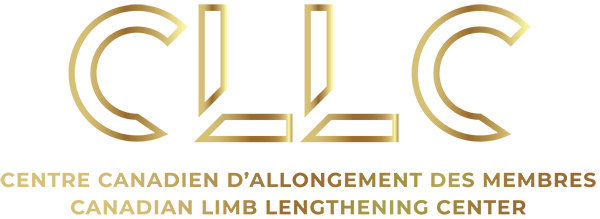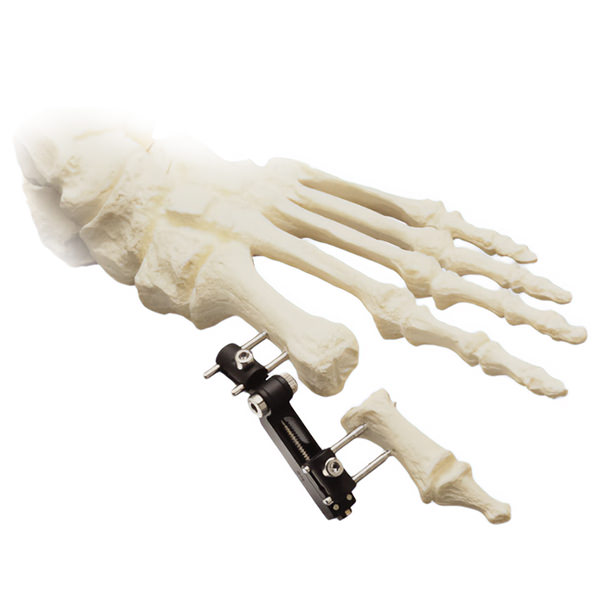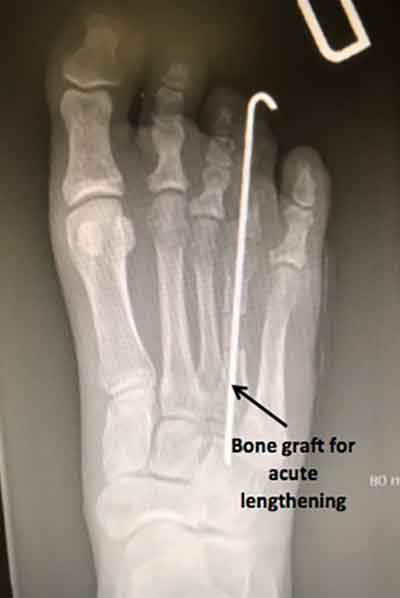Though some symptoms of Brachymetatarsia can be managed with non-surgical options like supportive shoes, orthotics, and activity modifications, some patients chose to undergo surgery to correct the condition. The aim of the surgery is to lengthen the metatarsal bone which can be done using Acute Lengthening or Gradual Lengthening with an external fixator called a Mini-Rail. The choice of the procedure depends on the length that is to be achieved. With Acute Lengthening the bony alignment is usually set during a single surgery. During Gradual lengthening the corrections are performed over several weeks or months and may involve 1-2 surgical procedures to apply and remove an external fixator device.
Indications / Candidacy
Brachymetatarsia is a congenital (present at birth), shortening of the toe, where there is a disturbance to the growth of the toe. It happens most commonly in the fourth toe, although it could affect any toe. The toe itself is usually of normal length, but the bone to which the toe attaches in the arch (the metatarsal bone) is short. It is sometimes described as a floating toe. It occurs more often in women than in men, and is often bilateral (both sides).
Good Candidates for acute and gradual lengthening to treat Brachymetatarsia may have:
- Pain associated with the short toe
- Difficulties with shoe wear such as rubbing and irritation of the shorter toe
- Shorter toe causing functional limitations for walking/sports
- Appearance of the toe (cosmetic and social impacts)


Treated Conditions
The Canadian Limb Lengthening Center offers a team of experienced surgeons, nurses and physiotherapists that make patients feel supported throughout their entire treatment process. Our ability to treat complex orthopedic conditions with a holistic approach gives our patients the best possible outcomes. We pride ourselves in providing highly specialized, expert care. To learn more about Brachymetatarsia follow the links below:
Surgical Technique
Arthrodesis can be performed either arthroscopically (with a camera) or with a traditional open approach. Arthroscopic fusions are done using two small incisions at the front or back of the foot. An open technique may be performed from the front, back or lateral aspect of the foot.
Results
After treatment, the short toe is lengthened and has improved alignment with surrounding toes. These results give our patients a more comfortable and pain free experience, especially when walking in common footwear like sneakers or dress shoes. After the bone is fully consolidated and healed, the patient can fully weight bear on the foot. This surgery has very high success rates and our patients are very happy with their treatment outcomes.


Potential Complications
As with any surgical procedure, acute and gradual lengthening to treat Brachymetatarsia can have difficulties and complications. In most cases, our team of specialists can address these concerns without compromising the end results or outcome. Complications and side effects may include:
- Infection (superficial or deep)
- Pain (temporary or permanent)
- Swelling
- Delayed union, non-union or mal union of the bone
- Over lengthening
- Premature consolidation (for gradual lengthening)
- Subluxation of toe
- Stiffness of toe and arthritis
- Metatarsalgia
- Fracture of toe
Case studies
AM I A CANDIDATE?
Are you experiencing an orthopedic condition and would like to improve your physical capabilities?
Or you simply would like to achieve your long-lasting dream of improving your height?
Let us help you achieve your optimal health and wellness in a professional setting.
Let’s open up a discussion to help you achieve your goals.




Highly specialized expert care at CLLC
At the Canadian Limb Lengthening Centre we offer complex deformity correction and limb lengthening surgeries performed by experienced surgeons with the most up to date technologies. When it comes to your care, and treatment of deformity and limb length discrepancy, our surgeons have extensive training and experience.






